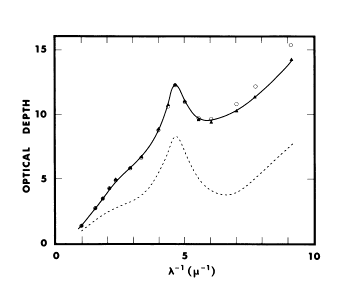Interstellar Extinction Curve, The
Lesson - The Interstellar Extinction CurveOne of the primary ways astronomers have for studying the make up of the interstellar medium is the average interstellar extinction curve. Light from stars is partially obscured as it travels the distance to Earth. While we cannot know the total amount of absorbed light without knowing the distance to the star, we can determine the relative amount of absorption at different wavelengths of light by comparing to known stellar types. The standard method of displaying this is the extinction curve, which is a plot of absorption versus inverse wavelength. (Inverse wavelength is used purely for historical reasons.) 
The above image (taken from Mathis, Rumpl, and Nordsieck (1977)) shows the average interstellar extinction curve as the solid line. When we do this, we see some features which are found repeatedly in stellar observations. We see a smooth peak at ~0.2 microns for all sources, we see a linear rise in the visible for all sources, and we see a strong rise in the ultraviolet for all sources. Exercise:
|



